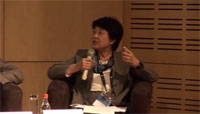JAXA Astronaut Activity Report, October 2011
Last Updated: December 19, 2011
This is JAXA's Japanese astronaut primary activity report for October, 2011.
Astronaut Wakata participates in the NOLS

Wakata sea kayaks (Credit: JAXA/NASA)
From October 8-15 (U.S. time), Astronaut Wakata participated in the National Outdoor Leadership School (NOLS) organized by the NASA.
In the NOLS, the participants take turns to become the leader on different days and train under an environment similar to that of the ISS stay, to help them understand and acquire self-management and teamwork skills such as leadership and followership, as well as decision making depending on circumstances.
This time, the NOLS training was conducted around the San Juan Islands, in the State of Washington, U.S. Wakata participated with seven astronauts from NASA and the European Space Agency (ESA). After the hands-on training involving paddling and the safety of sea kayaking, they traveled among islands via kayak and camped for about a week.
Astronaut Onishi participates in the NEEMO training

Onishi collects rock samples (Credit: JAXA/NASA/NOAA/UNCW)
Astronaut Onishi participated in the 15th NASA Extreme Environment Mission Operations (NEEMO).
The NEEMO training was conducted in an underwater laboratory called AQUARIUS, located off the coast of Florida at a depth of about 20 meters. The purpose of NEEMO is to foster leadership, teamwork and self-management skills based on co-habitation within the ultimate environment, similar to those used in space flight. It is also intended to help develop new technology and manned mission operation technology for asteroid exploration and the ISS.
In the 15th NEEMO, the participants envisaged asteroid explorations simulating undersea microgravity and assessed locomotion on asteroids and the collection method used for rock and soil samples.
Through co-habitation within a closed facility with little privacy, Onishi and the other participants learned to assist and pay attention to each other and communicate smoothly with the ground.
- NEEMO(NASA's website)
Meanwhile, Astronauts Yui and Kanai continue their training along with each training program at the NASA Johnson Space Center.
Astronaut Hoshide speaks with the TKSC

Hoshide and the audience at the conference room in TKSC (Credit: JAXA)
JAXA held an open house event at the Tsukuba Space Center on October 15 to commemorate "Space Day." As one of the events, Astronaut Hoshide talked to the audience gathered at the conference room in the Tsukuba Space Center (TKSC) via live satellite broadcast from Houston, U.S. where he is currently training.
Hoshide reported on his current activities, commented on his upcoming second space flight, and reminisced about TKSC, where he had worked before becoming an astronaut, and his current training venue.
In response to the question from one of the audience "What was the hardest training?", he responded, "Physically, the hardest training is Russia's survival training." He added "In a different way, also learning a new language, Russian, is tough especially when you are past 30." Many people in the audience nodded in agreement.
Regarding the ISS system, the Water Recovery System (WRS) received attention from the audience and several high-level technical questions were also raised. The "future junior astronauts" children asked Hoshide "What are the key things to becoming an astronaut?" "What do you want to do in space?" and "Why do you think you were chosen to be an astronaut?" Hoshide answered, "Well, I have no idea. Ask those who chose me", giving a bashful smile, which relaxed the audience.
Hoshide is currently continuing the training for his upcoming ISS long-duration mission. In October, he received training on the Extravehicular Activity (EVA) using the Neutral Buoyancy Laboratory (NBL) pool at the Johnson Space Center. Hoshide also participated in the joint simulation for "KOUNOTORI" the H-II Transfer Vehicle (HTV) rendezvous and capture operation of the Space Station Remote Manipulator System (SSRMS) with the JAXA Flight Control Team (JFCT) in TKSC and NASA's Flight Controllers in Houston.
- Twitter (@Aki_Hoshide)
Astronaut Mukai attended the 62nd International Astronautical Federation

Mukai comments at the panel discussion (Credit: JAXA)
Astronaut Mukai attended the 62nd International Astronautical Congress (IAC) held in Cape Town, the Republic of South Africa.
The IAC is the world's largest space related conference, featuring thousands of participants from space agencies, companies, and universities from all over the world to present their country/agency's space development plans and their research results, including students' participation and various exhibitions.
Mukai gave a speech on the educational activities utilizing the unique space environment. Mukai also attended a panel discussion with astronauts from NASA, the ESA, and Russian cosmonauts. They reviewed the progress of human space flight, half a century since Yuri Gagarin's first human flight into space and discussed the future half century.
Mukai reviewed Gagarin's flight "I was so impressed by what he did because I clearly remembered his comments "the Earth is blue". His flight led the Japanese to a new world. With regard to future human space flight, Mukai stated that further interdisciplinary approaches were imperative. Mukai also remarked that the values of intangible results should be respected, e.g. Gagarin's comments on the Earth instilled the belief in people that the Earth was beautiful and fragile.





I participated in the marine NOLS conducted around the San Juan Islands, in the State of Washington.
A team of eight astronauts and two instructors was formed. Every day, before starting our mission, the members checked and forecast the weather and decided on contingency plans with the input of the leader.
It was an excellent opportunity for us to learn and train in self-management to ensure the safe and effective accomplishment of our mission as well as the ability to take collective action, such as leadership, followership, and the team working.
Our team included three of my crewmates for the upcoming ISS long-duration mission. The training was a very meaningful experience since we could share time together before the mission. I will keep striving to optimally exploit this training experience for my upcoming mission as commander.